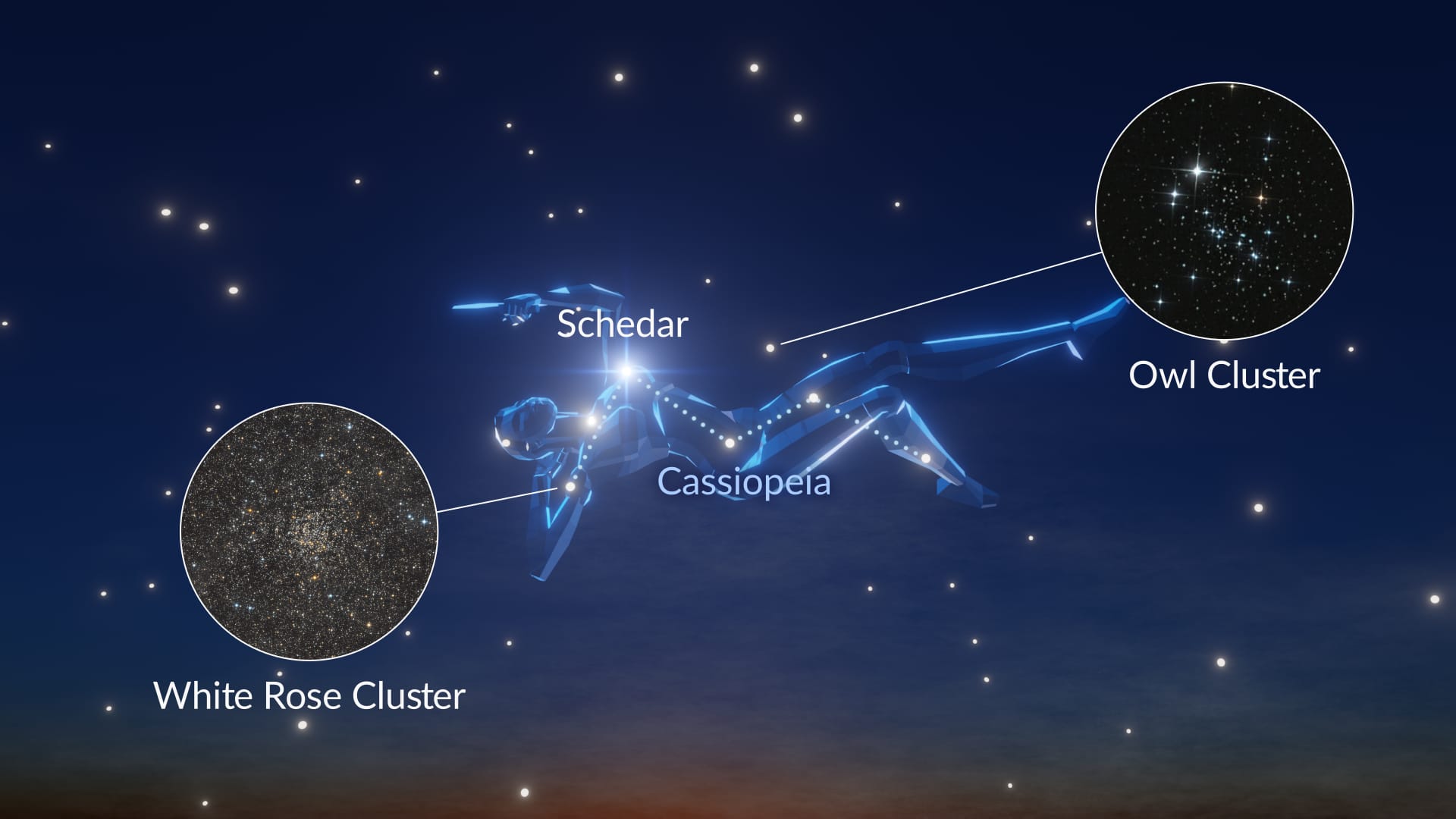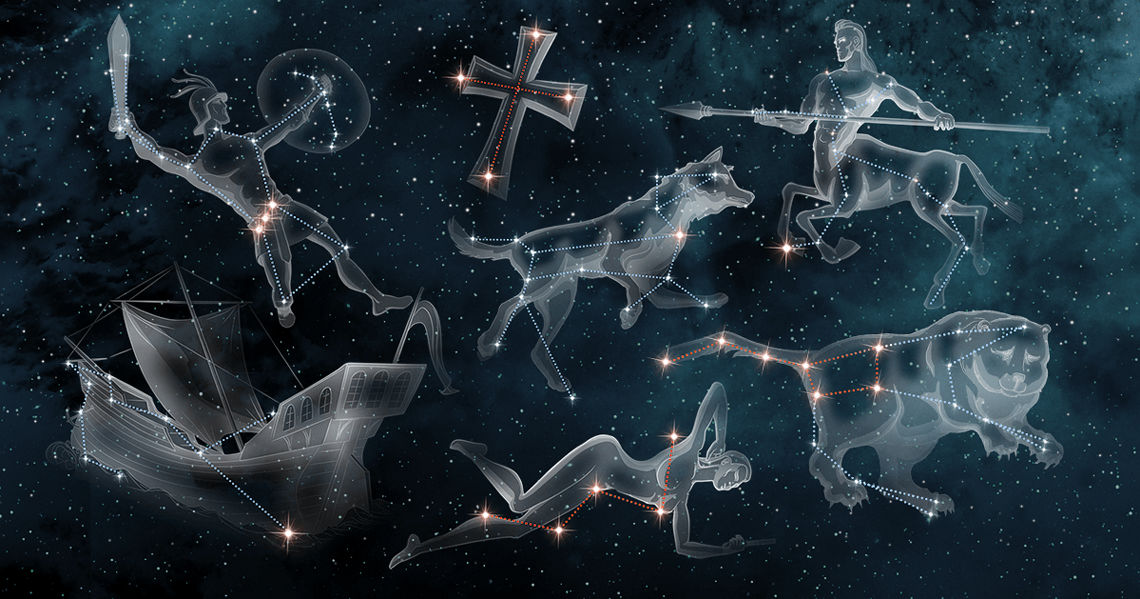What Constellations Are Visible in November 2025: Six Targets For You
This November, the night sky invites you to spot six constellations — from the bright Cassiopeia and Andromeda to the fainter Pisces, Sculptor, Phoenix, and Tucana. Ready to find them? Follow our guide and use Star Walk 2 for the AR sky map.
Contents
- Introduction
- List of November constellations
- More to see in the November night sky
- What is a constellation, and how does it differ from an asterism?
- How to locate a constellation?
- Best November constellations: bottom line
Introduction
Welcome to our monthly series on the best constellations to observe. In November, the sky highlights include Cassiopeia, Andromeda, Pisces, Sculptor, Phoenix, and Tucana.
We’ve organized all 88 constellations by the month they’re best seen — the month they cross the local meridian around 9 p.m., reaching their highest point.
Best observation time: about 9–10 p.m. local time.
To navigate the night sky easily, use the free Star Walk 2 app.
List of November constellations
Cassiopeia
- Brightness: ☆☆☆
- Visible from: 90°N to 20°S
- Brightest star: Schedar (mag 2.2)
- Best deep-sky objects: White Rose Cluster (NGC 7789, mag 6.7), Owl Cluster (NGC 457, mag 6.4)

How to find Cassiopeia in the November night sky
Cassiopeia is one of the easiest constellations to spot, thanks to its distinctive W (or M) shape. From latitudes around 46°N and higher (e.g., the northern United States and Canada), it’s circumpolar, meaning it never sets.
In the Northern Hemisphere, look high in the northern evening sky and trace the W shape. The middle three stars point toward Polaris in Ursa Minor. In the Southern Hemisphere, Cassiopeia hugs the northern horizon, and it is not visible from latitudes below 20°S (e.g., Sydney).
Cassiopeia is opposite the Big Dipper across the pole star. When Cassiopeia is high in the sky (roughly from September to February), the Big Dipper is low. By March, the Big Dipper ascends in the northeast as Cassiopeia descends in the northwest.
Myth of the Cassiopeia constellation
According to Greek mythology, Cassiopeia was a vain queen who boasted that she and her daughter, Andromeda, were more beautiful than the sea nymphs, the Nereids. This angered Poseidon. In response, he sent the sea monster Cetus to ravage her kingdom. In order to pacify the monster, Andromeda was chained to a rock to be sacrificed, but Perseus arrived on Pegasus and rescued her.
They were all placed among the stars, and as a lesson in humility, Cassiopeia’s "Chair" circles the North Celestial Pole, appearing upright or upside down through the seasons — sometimes like an M and sometimes like a W.
Andromeda
- Brightness: ☆☆
- Visible from: 90°N to 60°S
- Brightest star: Alpheratz (mag 2.0)
- Best deep-sky object: Andromeda Galaxy (M31, mag 3.4)

How to find Andromeda in the November night sky
Andromeda lies beside Cassiopeia, between the W-shaped constellation and the Great Square of Pegasus. Its brightest star, Alpheratz, marks Andromeda’s head and forms the northeastern corner of the Great Square of Pegasus. The star Schedar in Cassiopeia, located at the W’s bottom-right tip (or the M’s upper-left tip), points directly toward Andromeda.
From the Northern Hemisphere, Andromeda stands nearly overhead on November evenings. In the Southern Hemisphere, it appears low above the northern horizon but remains visible for most of the southern latitudes.
The constellation’s highlight is the Andromeda Galaxy (M31), the nearest major galaxy to our Milky Way. Under dark skies, it’s visible to the naked eye as a faint, elongated patch of light. This glow comes from billions of stars whose light has traveled 2.5 million years to reach us — making it one of the most distant objects visible without optics.
Andromeda Galaxy tops the list of the easiest deep-sky objects in the Northern Hemisphere for beginners. Check out our guide to discover how to spot the brightest galaxies, nebulae, and star clusters — no special equipment required.

Myth of the Andromeda constellation
In Greek mythology, Andromeda was the daughter of King Cepheus and Queen Cassiopeia of Ethiopia. Cassiopeia angered Poseidon, the god of the sea, by claiming that she and Andromeda were more beautiful than his sea nymphs, the Nereids. In retaliation, Poseidon sent the sea monster Cetus to ravage the coast.
An oracle declared that the kingdom could only be saved by sacrificing Andromeda to the monster. She was chained to a rock by the sea. However, Perseus saw her, fell in love with her, and defeated Cetus by turning it to stone with the head of Medusa. Perseus freed Andromeda, and they later married.
To commemorate their story, all the key figures — Andromeda, Perseus, Cassiopeia, Cepheus, and Cetus — were placed among the stars.
Pisces
- Brightness: ☆☆
- Visible from: 90°N to 65°S
- Brightest star: Alpherg (mag 3.6)
- Best deep-sky object: Phantom Galaxy (M74, mag 9.5)

How to find Pisces in the November night sky
Pisces is a dim constellation, so seek out a dark, rural sky to see it best. This constellation stretches south of the Great Square of Pegasus, and it is easiest to recognize by the Circlet, which is a compact ring of seven faint stars that mark the head of the Western Fish.
In the Northern Hemisphere, look above the southern horizon on autumn evenings. In the Southern Hemisphere, look low in the northern sky.
First, locate the Great Square of Pegasus. Below its southern edge, pick out the Circlet. Its brightest star is Alpherg, also known as Gamma Piscium. From the Circlet, trace the long, faint strands eastward and upward to the Eastern Fish. Altogether, the pattern resembles a wide letter "V."
Myth of the Pisces constellation
According to Greek mythology, the goddess Aphrodite and her son Eros transformed into fish and leaped into the Euphrates to escape the monster Typhon. To avoid being separated, they tied themselves together with a cord. The constellation Pisces depicts two fish linked by a ribbon, commemorating their escape.
Sculptor
- Brightness: ☆
- Visible from: 50°N to 90°S
- Brightest star: Alpha Sculptoris (mag 4.3)
- Best deep-sky object: String of Pearls Galaxy (NGC 55, mag 7.8)

How to find Sculptor in the November night sky
The Sculptor constellation is faint and can only be seen with the naked eye under dark, clear skies. Its three brightest stars, around magnitude 4, form a small triangle in the night sky.
In the Northern Hemisphere, look low above the southern horizon in November evenings; in the Southern Hemisphere, Sculptor passes nearly overhead. The constellation lies between Aquarius and Phoenix, just south of the Great Square of Pegasus.
Myth of the Sculptor constellation
The Sculptor constellation has no connection to ancient mythology. It depicts a sculptor at work and was introduced by Nicolas Louis de Lacaille in the 18th century.
Phoenix
- Brightness: ☆
- Visible from: 30°N to 90°S
- Brightest star: Ankaa (mag 2.2)
- Best deep-sky object: IC 5328 (mag 10.8)

How to find Phoenix in the November night sky
The first step in locating the constellation Phoenix is to spot the bright star Achernar (mag 0.4) at the southern end of the constellation Eridanus — it’s a useful landmark. Phoenix lies northwest of Achernar, between the constellations Sculptor and Grus. The brightest star in Phoenix is Ankaa, which forms a faintly visible kite shape with the nearby stars.
In the Southern Hemisphere, look high in the southern sky on November evenings. From latitudes around 30°N, the constellation skims very low above the southern horizon. Farther north, it doesn't rise.
Myth of the Phoenix constellation
Named after the legendary bird that is reborn from its own ashes, Phoenix is one of the southern "bird" constellations, along with Grus, Pavo, Tucana, and Apus. Petrus Plancius charted it in the late 16th century based on observations by Keyser and de Houtman. Johann Bayer's Uranometria of 1603 was the first celestial atlas to depict this constellation.
Tucana
- Brightness: ☆
- Visible from: 15°N to 90°S
- Brightest star: Alpha Tucanae (mag 2.8)
- Best deep-sky objects: Small Magellanic Cloud (mag 2.7), 47 Tucanae (NGC 104, mag 4.0)

How to find Tucana in the November night sky
Tucana circles close to the south celestial pole, making it visible year-round in the Southern Hemisphere. From northern latitudes, the constellation lies below the horizon — only observers south of about 15°N can see it.
In southern skies, look toward the south to find a faint group of stars. Though the stars themselves are not bright, Tucana is easily located thanks to its spectacular deep-sky objects: the Small Magellanic Cloud, a nearby dwarf galaxy, and the globular cluster 47 Tucanae, both visible to the naked eye under a dark sky. These objects dominate the constellation’s southern region and outshine its individual stars.
Myth of the Tucana constellation
Tucana represents a toucan — a tropical bird known for its colorful bill. It’s a relatively modern constellation introduced by Flemish astronomer Petrus Plancius in 1598, based on observations by Dutch navigators Pieter Dirkszoon Keyser and Frederick de Houtman. The constellation commemorates the exotic wildlife encountered during early voyages to the Southern Hemisphere.
More to see in the November night sky
On November 5, 2025, look up as soon as the Sun sets — the biggest Full Moon of the year will rise in the sky. The Moon will reach its full phase near perigee, the closest point to Earth in its orbit, creating a Supermoon. It will appear about 8% larger and 16% brighter than an average Full Moon, making it a striking sight on the evening horizon.
Around the same time, the Taurid meteor shower will reach its peak of activity. The International Meteor Organization has warned of possibly enhanced Taurid activity in 2025. Normally, a bright Full Moon would make meteor viewing difficult, but since Taurids often produce slow, bright fireballs, there’s still a good chance of spotting some.
Later in the month, the Leonid meteor shower will peak on the night of November 17–18, just three days before the New Moon — perfect conditions for observation. Expect around 15–20 meteors per hour at the peak, under dark skies.
And don’t miss Comet Lemmon at the beginning of the month. For observers in the Southern Hemisphere, early November offers the best chance to see the comet, glowing faintly in the evening sky.
Learn more: All Astronomical Events in November 2025.
What is a constellation, and how does it differ from an asterism?
-
Constellations are groups of stars that appear to form a pattern when viewed from the Earth.
-
Asterisms are bright star patterns that are usually easily recognizable but are not officially registered as constellations.
Remember this key difference! For more details about constellations, take a look at our dedicated article.
How to locate a constellation?
The easiest way to make sure you're looking at the right constellation is to use Star Walk 2. Just point your device at the sky, and the app's sky map will adjust to match the stars in your exact location. It's that easy!

If you’d like to challenge yourself and learn to locate constellations without the app, check out our infographic. It will help you find constellations using familiar star patterns as guides.

Best November constellations: bottom line
November is an ideal time to observe these constellations around 9–10 p.m. local time: in the northern latitudes — Cassiopeia, Andromeda, and Pisces; in the southern ones — Sculptor, Phoenix, and Tucana. Choose a dark site, give your eyes 15–20 minutes to adapt to the darkness, and use bright objects — Schedar, Alpheratz, and the Great Square of Pegasus — to navigate between targets. Use Star Walk 2 to confirm or identify objects on the sky map.
